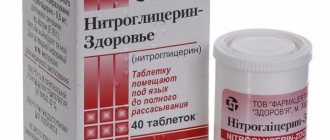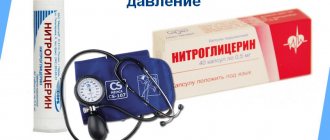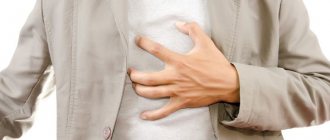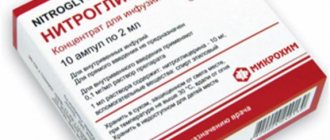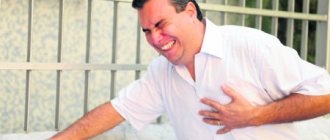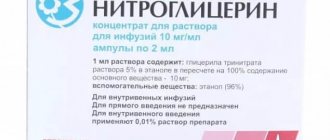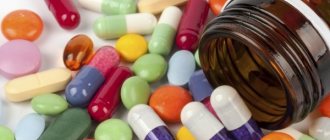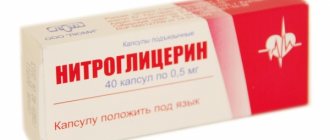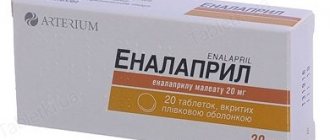Beneficial effects on the body
You can take Nitroglycerin not only for pain caused by myocardial ischemia. What else does the drug help with?
To justify the medicinal qualities of the drug, it is necessary to consider what happens after taking the medicine:
- arteries dilate (not only coronary ones, cerebral and peripheral vessels dilate), which helps lower blood pressure and reduce intracranial pressure;
- the smooth muscles of the internal organs relax (spasms of the intestines, gall bladder and stomach decrease);
- the myocardial oxygen demand decreases and metabolism improves;
- the contractility of the heart muscle increases;
- a redistribution of blood flow occurs in the cardiac arteries due to a decrease in venous return of blood to the heart;
- blood flow in the pulmonary circulation improves (prevention of blood stagnation during right ventricular hypertrophy).
The use of Nitroglycerin gives an antispasmodic effect and helps eliminate pain.
But, in addition to cardiac ischemia, there are some other indications for which the drug helps:
- biliary dyskinesia;
- spasms of smooth muscles of the gastrointestinal tract (gastric and intestinal colic, also helps with spastic constipation);
- embolism of the central ophthalmic artery (acute disruption of the blood supply to the retina).
It is almost always recommended to use Nitroglycerin under the tongue as a means to quickly relieve symptoms, to reduce heart pain or spasm of the smooth muscles of the digestive system.
Long-acting medicine is prescribed infrequently, only if exposure to the active component is required during the day.
How can you replace Nitroglycerin: popular analogues
The drug Nitroglycerin is indicated for cardiac pathologies. The medicine is taken as prescribed by the doctor. However, in some cases, it becomes necessary to replace the drug with an analogue. The selection of a Nitroglycerin substitute should be carried out by the attending physician, depending on the characteristics of the body and the clinical picture.
Nitroglycerine
The drug belongs to the group of antianginal agents that promote the release of nitrogen oxides in the blood vessels. The action of the medicine is aimed at relieving the tone of smooth cardiac muscles, normalizing blood circulation and blood pressure. It has an antispasmodic, vasodilating and analgesic effect during heart attacks.
The medication is indicated for preventing and blocking attacks of angina pectoris, heart failure and myocardial infarction. The active ingredient is nitroglycerin. Available: patch, injection solution, spray and sublingual tablets.
Contraindications:
- collapse or shock;
- arterial hypotension;
- obstructive hypertrophic type cardiomyopathy;
- myocardial infarction, accompanied by severe arterial hypotension;
- constrictive pericarditis;
- cardiac tamponade;
- toxic pulmonary edema;
- high intracranial pressure;
- intraocular pressure in closed glaucoma;
- sensitivity to components.
The cost of the medicine is from 25 rubles. Up to 80 rub.
Note!
Taking the drug during pregnancy, lactation and in case of renal failure is permissible only in severe cases, strictly as prescribed by a doctor.
What can be replaced
The price of the drug is quite low, therefore, as a rule, the reason for selecting an analogue is contraindications or the need to take a more potent drug.
Depending on the reasons for replacing Nitroglycerin, an analogue with similar composition (if there are no contraindications to nitroglycerin) and pharmacological properties is selected.
Nitrocore
The drug is considered a complete analogue of Nitroglycerin, with the only difference: the composition is supplemented with the substance - dextrose. Nitrocor helps relax the heart muscles and blood vessels, lowers blood pressure and reduces the rate of blood flow to the atrium (right).
The use of Nitrocor is indicated for the prevention and emergency relief of an attack of angina, pre-infarction and heart failure. It is also prescribed in the post-infarction period for therapeutic purposes. The main substance of the composition is nitroglycerin. The drug is produced in three forms: injection and tablet (sublingual).
Contraindications:
- children's age (up to 18 years);
- intolerance to constituent substances;
- phenylketonuria;
- shock or collapse
The average cost of Nitrocor is 50 rubles.
Dikor Long
Another absolute analogue of the drug Nitroglycerin is Dikor Long. The drug promotes rapid relaxation of vascular smooth muscles.
As a result of the use of Dicor Long, venous vessels dilate and the rate of return of blood vessels to the heart decreases, which prevents overload of the organ.
In high dosages, it reduces vascular systemic resistance and improves cardiac activity. The medicine also blocks coronary spasms and reduces oxygen consumption by the heart.
Dicor Long is indicated for the treatment and prevention of various types of angina pectoris (including myocardial infarction) and complex treatment of severe chronic heart failure. The active ingredient of the drug is isosorbide denatured alcohol. Available in tablets (long-acting) in different dosages.
Contraindications:
- vascular collapse or any form of shock;
- sensitivity to the composition;
- severe hypotension;
- hypertrophic cardiomyopathy (obstructive);
- constrictive pericarditis;
- cardiac tamponade;
- severe anemia;
- high intracranial pressure;
- hypovolemia or severe bleeding;
- mitral or aortic type of stenosis;
- hypothermia;
- angle-closure glaucoma;
- decreased blood pressure during myocardial infarction.
The cost of Dikor Long is on average 250 - 300 rubles.
Perlinganite
An analogue of Nitroglycerin, containing nitroglycerin as an active ingredient. The action of Perlinganite is aimed at reducing the tone of vascular smooth muscles.
The drug belongs to the antianginal group of drugs.
The main property of the drug is to reduce the need of myocardial muscles for oxygen consumption due to the increased load resulting from the development of cardiac pathologies.
Like Nitroglycerin, Perlinganite is indicated for patients suffering from angina or heart failure to prevent attacks. The medicine has a strong effect on heart attacks. The drug is recommended for those at risk of myocardial infarction and during the rehabilitation period after an attack. The drug is available in the form of a solution for infusion.
Contraindications:
In pharmacies, the price of the analogue is much higher than Nitroglycerin. The cost of Perlinganite is from 650 rubles.
Nitromax
Taking Nitromax as a cardiac vasodilator promotes rapid relaxation of the walls of venous and arterial vessels. as a result, spasms of the heart muscles are eliminated, blood circulation is normalized, myocardial muscles no longer need large amounts of oxygen, pain in the heart is reduced, and the functioning of the organ is stabilized.
The drug is used for preventive and therapeutic purposes in vascular diseases caused by heart failure. Nitromax is mainly taken during an exacerbation or attack during ischemia or the risk of myocardial infarction. The medicine is produced in tablet form with different dosages of nitroglycerin.
Contraindications:
- cardiac tamponade, cerebral ischemia, obstructive cardiomyopathy;
- sensitivity to constituent substances;
- pressure too low;
- angle-closure glaucoma, intraocular and intracranial pressure;
- shock, acute phase of myocardial infarction, collapse.
The price for a package of tablets is from 1200 rubles.
Note!
Nitroglycerin can be replaced with an analogue only with the consent of the attending physician.
Nitroglycerin and its analogues have a strong effect on the heart, so taking drugs in this group without a doctor’s prescription is not recommended. It should also be remembered that medicinal substances have contraindications and can cause adverse reactions.
Source: https://sosud-ok.ru/polza/est-li-analogi-u-nitroglitserina.html
Release form and admission rules
A person suffering from angina attacks is familiar with Nitroglycerin tablets, but sometimes the pharmacy can offer sprays or capsules.
Let's consider the content of the active ingredient in each release form:
- Tablets 0.5 g. in bottles of 40 pcs. and in blisters of 10 pcs.
- Red spherical capsules filled with a 1% oil solution (capsule dosage 0.5 g of active ingredient), in blisters of 10 or 20 pcs.
- 1% alcohol solution in bottles with a spray dispenser for spray of 10 ml.
- 1% alcohol-based solution for drip use (rarely available).
Although the tablet form of Nitroglycerin, which is familiar to everyone as a medicine, can be replaced with a solution or capsules, the dosage does not change. One tablet corresponds to: 1 capsule, 2 doses of spray (2 clicks on the dispenser) or 2 drops of alcohol solution. The medicine is taken sublingually:
- the tablet or capsule is placed under the tongue and held until completely dissolved;
- the spray is applied by spraying 1-2 doses onto the root of the tongue;
- The alcohol solution is used by applying 2 drops using a drop dispenser under the tongue (it is possible to apply the drops to a piece of bread or sugar and then dissolve).
Sometimes patients with severe forms of angina are prescribed prolonged Nitroglycerin in tablet form. In this case, the drug must be taken, like most other tablets, with a small amount of water. The cardiologist determines how to take a long-acting medication individually, taking into account the characteristics of the disease.
When should you not take nitroglycerin?
Today, nitroglycerin is available in a variety of forms. It is possible to use nitroglycerin in tablets (orally or put under the tongue for resorption), used for external use, and also administered intravenously. It all depends on the doctor’s prescription and the form of the drug.
The following forms of nitroglycerin can be found in the pharmacy:
- Tablets or capsules. This form of the drug is usually used sublingually, that is, placed under the tongue and not washed down with water. It is not recommended to use more than three tablets at a time. Basically, the effect and noticeable relief can be noticed after taking one or two tablets or capsules. If the effect of the drug does not occur, you must urgently consult a doctor, it is even better to call an ambulance. Most often, nitroglycerin is taken in this way for angina pectoris.
- Tablets or capsules taken with water. Oral nitroglycerin is mainly taken to prevent an attack of angina. The medicine is washed down with plenty of water, one or two tablets are used at one time, in especially severe cases - three or four. The number of medications taken per day should be controlled by a doctor. You can consume no more than 34.8 mg of nitroglycerin per day.
- For intravenous administration, a special solution of nitroglycerin is used, including glucose or isotope solution. The injections are given by a doctor; this form is not used for self-administration.
- Patch. Nitroglycerin patches are used throughout the day. They are used more for the prevention of diseases, alleviate and improve the patient's condition.
It is not recommended to use nitroglycerin, the indications for which we have reviewed, in any of the available forms without first consulting a doctor.
This is a truly effective drug that affects blood circulation in the body, but self-treatment can lead to exacerbation of other diseases.
Sometimes people during an angina attack try to endure the pain so as not to use medications. It is strictly forbidden to do this, because increasing pain is more difficult to stop and can lead to serious complications.
Nitroglycerin has the following forms of release: tablets, capsules, Votchal drops, solution (less often). Taking the drug, its permissible single and daily dosage depend specifically on the form of release:
- If the medicine is in the form of a tablet or capsule, then it is placed under the tongue until completely dissolved, which occurs within a minute. If the pain does not subside, then after a few minutes you are allowed to take a second dose. Be sure to call emergency medical assistance. To avoid an overdose, the next time the drug can be taken no earlier than half an hour later, when the nitroglycerin that has already entered the body will be absent from the blood. The maximum daily dose is six tablets;
- Nitroglycerin at high pressure in the form of an alcohol solution is applied to a small piece of refined sugar and also placed under the tongue until completely dissolved. The solution itself should be applied from two to four drops at a time. The maximum allowed amount per day is sixteen drops;
- If a person has poor sensitivity to nitroglycerin, then it is better to use Votchal drops. In addition to the active ingredient, these drops contain menthol, tincture of lily of the valley and belladonna. The combination of the components of the drug makes it easier for the patient to tolerate its use, because menthol helps reduce headaches. One dose will require ten drops.
Indications for the heart:
- Angina pectoris and its prevention.
- Necrotic foci in the myocardium (acute ischemic necrosis).
- Heart failure.
- With hypertensive crisis and accompanying pain in the heart.
Also indicated for pulmonary edema (4 doses in the form of an aerosol, 1% solution intravenously), acute pancreatitis, and decreased motility of the biliary tract. During operations in the neurosurgery department, Nitroglycerin is used as a means of artificially lowering blood pressure.
If necessary, a nitroglycerin tablet or capsule is placed under the tongue, but not swallowed. The medicine dissolves (within 1 minute) and causes an analgesic effect;
2-4 drops of nitroglycerin solution are applied to a small piece of sugar and kept in the mouth under the tongue, without swallowing, until completely absorbed;
Apply 2-3 drops of nitroglycerin solution to the tongue or under the tongue. 3 drops of solution correspond to one tablet.
If the patient does not tolerate nitroglycerin well, then it is better to use Votchal drops. In addition to nitroglycerin, they contain menthol, tincture of lily of the valley, and belladonna. In this combination, nitroglycerin is better tolerated due to the fact that menthol reduces headaches from taking this drug. Take these drops 10-12 drops per dose.
If the pain does not go away, then after 1-3 minutes you can put a second tablet and even a third under your tongue. It is also necessary to call an ambulance. To avoid an overdose, take the next tablet no earlier than 15-30 minutes later, when the effect of the nitroglycerin already taken has ended.
The use of the drug in any pharmaceutical forms should be abandoned if the patient:
- Individual intolerance to the drug
- Circulatory disorders (vascular or cardiogenic collapse)
- Hypotension
- Intracranial hypertension
- Toxic pulmonary edema
- Severe anemia
- Acute myocardial infarction
- Angle-closure glaucoma
- If you are taking sildenafil
- Alcohol intoxication
In the latter case, you should know that you should not drink alcohol for at least 3 hours after taking nitroglycerin. Since it is impossible to understand whether an attack of pain is caused by angina pectoris or another pathology.
And, in addition, a sharp drop in blood pressure, which can be caused by nitroglycerin, against the background of intoxication, is fraught with various consequences, including those requiring emergency medical intervention.
The correct thing to do in this case would be to send the patient to the hospital by ambulance.
Effect on potency
Nitroglycerin ointment is used to increase potency as a local vasodilator. The quality of erection and the speed of its onset entirely depend on the condition of the vessels of the penis. Through them, blood reaches the cavernous bodies and fills them, giving the organ elasticity and increasing its size. Using the product a few minutes before sexual intercourse will increase blood flow and increase potency.
Instructions for use: apply the ointment in a small amount to clean, dry skin of the penis, rubbing lightly. It is not recommended to smear the head and foreskin. Hands must be washed with soap after the procedure.
The drug is quickly absorbed, the effect of vasodilation occurs after 2-3 minutes. The pronounced local effect does not last long.
To avoid allergic reactions on the part of a woman, a condom should be used. A course of nitroglycerin for erection to treat impotence of vascular origin can only be prescribed by a doctor.
Global manufacturers (Futura Medical, GlaxoSmithKline) began to include nitroglycerin in new products to enhance potency: creams, gels (Med 2002 has already been released for sale), balms. The drugs are sold not only in pharmacies, but also through retail outlets.
Foreign analogues of nitroglycerin ointment:
- Nitrogesic;
- Rectogesic;
- Nitro-Bid (2%).
At the moment, in Russia their purchase is possible through the official websites of distributors.
"Nitrocore"
"Nitrocor" is a medicinal product containing the same active ingredients as nitroglycerin. That is why it also acts quickly, helping to relieve an attack of angina. "Nitrocor" can also be used as a prophylactic agent.
The main method of application is under the tongue. In addition to the main components, the medicine contains sugar, dextrose and starch. It is not recommended to constantly use the drug, as it is addictive. You can take short breaks, thanks to which the body will again perceive the remedy properly.
Pharmacological properties of the drug
Drug therapy includes 4 groups of drugs:
nitrates;
beta blockers;
calcium channel blockers;
Ranolazine
Nitrates (nitroglycerin and its analogues) for angina pectoris, as well as beta blockers are first-line drugs. If the therapeutic effect is insufficient, calcium channel blockers are added to one of them.
Drug therapy for angina pectoris
The use of one or two drugs, as well as which one specifically, is recommended only by a doctor, focusing on the number of attacks that occur on average per week.
No more than one. It is recommended to take sublingual (under the tongue) nitroglycerin when an episode of angina occurs, or just before an event that may trigger an attack. The second option is constant (daily) use of medications (long-acting nitrates or beta blockers) according to a specific regimen.
Two or more. As a rule, long-acting antianginal agents, both nitrates and beta blockers, are used.
Therapy with the addition of a drug from another group. If an attack persists on one medication, a combination treatment is usually used and is usually effective.
If this does not help, then a third drug or coronary angiography may be recommended. Angiography can determine how serious the problem is in the coronary arteries and whether stenting or bypass surgery should be performed.
How to replace nitroglycerin for angina if it is poorly tolerated? For example, when taking this medicine, a patient experiences severe headaches, a sharp drop in blood pressure, etc.
Calcium channel blockers are a group of drugs that can be used both to relieve episodes of angina and to prevent them. But, as a rule, they are used for stable, that is, relatively well-running angina. You should not prescribe treatment for yourself! Any change in therapy requires consultation with a doctor.
We recommend reading about whether it is harmful to drink nitroglycerin every day. You will learn about the pharmacological effect of the drug on the human body, contraindications and side effects during treatment, and rules of administration. And here is more information about nitroglycerin analogues.
Nitroglycerin for high blood pressure
Is it possible to take nitroglycerin for high blood pressure? People with this problem periodically experience attacks of hypertensive crisis. This is a sharp and severe increase in blood pressure, which is accompanied by severe throbbing pain in the head, nausea and vomiting, severe sweating, blurred vision, and numbness of the facial muscles.
During an attack of hypertensive crisis, urgent medical attention is necessary, since such a condition is very dangerous and can lead to the development of a stroke.
Nitroglycerin is a kind of first aid for a hypertensive crisis. It quickly dilates blood vessels, due to which blood pressure begins to drop.
This drug will be especially useful for people who, in addition to headaches, also feel pain in the heart during an attack. The only disadvantage of the drug is that after the attack is relieved, the patient may experience headaches, which are a side effect of the drug.
Recipes for treating angina at home
Angina pectoris is pain in the heart area that occurs when the heart muscle is deprived of oxygen. The symptom occurs after stress, hypothermia, overeating or increased blood pressure. But most often, an attack begins after physical exertion, since this begins to increase the load on the heart and the myocardium’s need for oxygen, and the vessels damaged by atherosclerosis or spasmed are not able to provide it in the required quantity.
Is it possible to treat angina at home?
Sometimes help is needed when, for some reason, it is impossible to take the medicine, or get advice from a specialist. In such cases, the experience of our ancestors and ancient recipes of traditional medicine can be useful.
As monotherapy, taking natural remedies can stop an attack and prevent the next one. However, the attending physician must be aware of what the patient is taking.
Recipes with garlic and honey
The properties of garlic have long been used in folk medicine to treat heart pain. It helps reduce blood pressure, improves blood circulation by reducing thrombosis and resorption of cholesterol plaques.
- Garlic with honey. You need to take these two components in equal proportions and leave in a dark place, placing them in a container with a tight lid. Take according to Art. spoon before eating. This can be done for three months.
- If you add lemon to the mixture (10 lemons, 10 heads of garlic, a kilogram of honey), then the quality of the product will only improve. This composition is taken 3 teaspoons once a day, it is necessary to take a break between each spoon for at least a minute. The course continues until all the remedy is finished.
- Raisins, dried apricots, walnuts and prunes should be taken in equal proportions, add honey and add peeled and grated lemon. To stir thoroughly. This composition is ready for use immediately. Useful components - vitamins and microelements that are part of the mixture, help with any diseases of the heart and blood vessels, including in the case of angina pectoris. Honey in the amount of 300 g is best taken liquid or melted in a water bath. This is not only an effective remedy, but also very tasty.
Recipes with berries and herbs
How to treat angina at home? For this, various herbs and berries may be useful.
- The following composition will help improve your condition with heart pain and even recover after a heart attack. You need to take crushed hawthorn and rosehip fruits, pour them into a container and pour boiling water over them (10 tablespoons of hawthorn and 5 tablespoons of rose hips per 2 liters of water). Wrap in a blanket and leave for a day. Drink one glass before meals, three times.
- St. John's wort, valerian and yarrow should be taken in equal quantities. Leave in cold water for four hours (one tablespoon of mixture per 20 ml of liquid). Bring to a boil and wait 10 minutes. Set aside and keep for another two hours. Take 75 ml of infusion three times.
- Mix mountain arnica with crushed mustard seeds (4 to 1). Keep in a water bath for a quarter of an hour. Leave for 45 minutes, squeeze and strain. Take three times, after meals, one tbsp. spoon, dissolved in milk. This is a proven method of helping with angina pectoris and has been used for quite a long time.
- Take tincture of motherwort and lily of the valley in equal quantities and take it, adding 30 drops to your drink twice a day.
Adviсe
- For heart pain, it is recommended to take 5 drops of fir oil in a spoon or sugar cube. You can also massage the area of the heart muscle with this oil.
- If nitroglycerin is not available, you can swallow a clove of garlic during an attack.
- You can relieve pain, if there are no contraindications, by drinking 20 ml of cognac with added sugar.
- To alleviate the condition, you should apply mustard plaster to the left chest, and at the same time place cups on your back.
- Lemon zest can be used for treatment. It must be grated and taken before meals for a week.
Nashe-Serdtse.ru: details about the human heart and circulatory system
Welcome, dear visitors of our website! We wish you and your loved ones to forget about the pain in your heart forever and let it work smoothly!
Pain in the heart area is familiar to many, and some people think that they cannot be confused with anything. In reality this is not the case at all. What seems like pain in the area of the heart may turn out to be a symptom of intercostal neuralgia, and an incipient heart attack may be masked as an attack of a stomach ulcer.
OUR READERS RECOMMEND!
Our readers successfully use ReCardio to treat hypertension. Seeing how popular this product is, we decided to bring it to your attention.
A website devoted to all the features of heart pain and ways to relieve attacks before doctors arrive should help you understand such a serious issue, because the first hour after a heart attack sometimes becomes decisive for the patient’s return to a full life.
In what cases does pain on the left side of the heart require immediate medical attention, and when can you wait? Which doctor should I contact? What to do if pain in the heart bothers you, but there is no way to call doctors? Our site will provide answers to these and other serious questions.
Does the site’s information violate the first commandment of a doctor: “do no harm”? There can be only one answer: a new generation of people has grown up, who, in case of any ailment, go not to the clinic, but to the Internet, and this is done not only by young people, but also by much older people. In such a situation, it is important that the information found is reliable, reflects the real situation and gives correct recommendations to prevent or begin to treat serious cardiovascular diseases in a timely manner. However, in no case should it replace a full medical consultation with a specialist.
Possible causes of heart pain
Pain in the heart area can have different causes. They are divided into two categories:
- pain caused by heart damage;
- pain syndrome caused by other diseases, but radiating to the heart area.
The first type includes pain attacks caused by:
- disruption of the supply of oxygen from the blood to the heart muscle;
- changes in heart tissue as a result of inflammation;
- disturbances in tissue metabolic processes;
- excess load on the heart muscles due to defects or increased blood pressure.
The second type includes pain radiating to the heart, caused by reasons other than in the first group:
- ulcers and gastritis of the stomach;
- damage to the spine in the thoracic region;
- inflammation of the intercostal nerves or damage to the ribs;
- disease of the pleura and lungs;
- diseases of the esophagus.
For an accurate diagnosis, the patient needs to determine the type and duration of pain. Pain can be divided into groups:
- Stitching pain in the heart area (felt like “needle pricks”; may indicate neurosis of the heart, a disturbance in its nervous tone and nervous activity as a result of stress). Valerian drops and stress relief skills through relaxation or exercise help.
- Aching pain in the heart area, accompanied by “failures” of cardiac activity, fever and weakness may indicate myocarditis, which sometimes occurs as a consequence of tonsillitis.
- Pressing pain in the heart area often indicates angina pectoris, the aggravation of which is relieved by access to fresh air and a nitroglycerin tablet under the tongue. If the pain does not decrease, you should put a second tablet under your tongue and then call an ambulance.
- Sharp, sharp pain in the heart area that lasts half an hour or more may indicate a possible heart attack. In this case, nitroglycerin does not help; medical attention should be sought immediately.
- Dull pain in the heart area, which is perceived as heaviness, squeezing, aching or burning with a return to the left half of the body (shoulder, scapula, arm, collarbone or lower jaw) may indicate angina pectoris, and with a return to the hypochondrium or epigastric region - to the beginning pericarditis.
- Constant pain indicates the need to immediately consult a doctor.
Symptoms of heart pain can vary. It is very important to know the signs of heart pain so as not to confuse it with other types of pain. If, when trying to take a deep breath or change body position, the pain syndrome intensifies, this means that the pain is neuralgic in nature. For painful attacks caused by heart and vascular disease, a doctor prescribes a diagnosis and treatment method for heart pain. Heart pain can be caused by:
- myocarditis (with pain attacks of various types after or without exercise);
- myocardial ischemia (with pressing pain after overeating, physical activity or stress);
- pericarditis at the initial stage (with increasing pain in the heart when inhaling and changing the patient’s position, which radiates to the hypochondrium, the left arm and forces the patient to sit, leaning forward, and breathe shallowly);
- mitral valve prolapse (with prolonged pressing, pinching or aching pain in the heart, which is not relieved by nitroglycerin);
- angina pectoris (with pain relieved by nitroglycerin and fresh air);
- heart attack (with severe pain requiring qualified medical intervention);
- hypertension (dull pain is relieved with medications intended to lower blood pressure);
- arrhythmia (a painful attack is accompanied by weakness, a feeling of freezing or increased heartbeat, dizziness, and sometimes loss of consciousness; it can give back to the left side of the body (arm, half of the sternum and armpit);
- cardiomyopathy and myocardial dystrophy, in which pain can be of a different nature and radiate to different areas;
- vegetative-vascular (neurocirculatory) dystonia (heart pain during VSD and their treatment depend on the form of cardialgia and in simple cases can go away on their own).
What to do if you have heart pain?
If a heart attack is suspected, the patient should be seated, a bowl of hot water should be placed on his legs, preferably with mustard, validol should be placed under the tongue, about forty drops of Valocordin or Corvalol should be dripped, and if the pain attack does not go away, a nitroglycerin tablet should be given for resorption under the tongue.
Medicines for heart pain, such as validol, valocordin and nitroglycerin, should be in every home, and people over forty should simply have a bottle of nitroglycerin with them in case of an unexpected painful attack.
If the attack occurs suddenly, and the person does not have the skills to behave in such a situation, the main thing is to remain calm, since fear aggravates the pain. You need to try to relax and take validol under the tongue, and aspirin or analgin orally. If the situation does not improve within fifteen minutes, you should seek emergency medical help.
Nitroglycerin how the drug works
It dilates arteries and veins both in the heart and in other organs. This reduces the load on the heart muscle: it needs less energy to overcome vascular resistance. Due to this, the myocardium's need for oxygen is reduced.
Even in conditions of deteriorated blood flow in the coronary arteries due to atherosclerosis, reducing oxygen consumption by the heart allows it to pump more blood without developing ischemia (oxygen starvation) of the myocardium. The appearance of chest pain during angina pectoris during emotional stress or physical activity, when the need for oxygen increases, is a manifestation of myocardial ischemia.
Mechanism of antianginal action of nitroglycerin
By also dilating the coronary arteries, it improves oxygenation of the heart muscle, thereby reducing the likelihood of ischemia. But due to vascular damage by atherosclerosis, which leads to their narrowing, the vasodilating mechanism of action of nitroglycerin in angina pectoris on these arteries is not so significant and has a limited therapeutic effect.
However, there is the so-called Prinzmetal angina, which is largely caused by spasm of the coronary arteries, and not by organic vascular damage. In this situation, nitroglycerin is very useful.
Nitroglycerine
The medicinal substance that provides a therapeutic effect is nitroglycerin or, more precisely, glyceryl trinitrate.
The mechanism of action is achieved through its ability to activate the release of nitric oxide from vascular smooth muscle, which in turn activates guanylate cyclase and increases the concentration of cGMP. As a result of these chain reactions, the smooth muscles of the blood vessels relax. Moreover, the tone is most strongly removed in large arteries and veins. In addition, the rapid effect of nitroglycerin is due to its ability to relieve the increased oxygen demand for the myocardium by reducing pre- and afterload. The medicine also reorients blood flow, directing it to ischemic areas of the myocardium, increases the resistance of the heart muscle to increased physical activity, and reduces pressure in the pulmonary circulation.
The drug is available in several dosage forms - as a concentrate for infusion solution, sublingual spray, ointment. But the most popular are sublingual tablets.
Depending on the form, the medicine is used for dissolution in the mouth, intravenously, cutaneously or buccally (pasted on the inside of the oral mucosa or cheek).
Indications for taking Nitroglycerin:
- Oral: relief and prevention of angina attacks, rehabilitation after MI
- Sublingual, buccal: as an emergency treatment for acute forms of myocardial infarction and insufficient functioning of the left ventricle (before hospitalization), relief and prevention of angina attacks.
Like any medicine, Nitroglycerin has its contraindications. It is prohibited to take it when:
- Individual intolerance or hypersensitivity of the body
- Shock
- Collapse
- Hypotension
- Acute MI with severe hypotension
- Obstructive HCM
- Constrictive pericarditis
- Cardiac tamponade
- Toxic pulmonary edema
- High ICP (including in case of cerebral hemorrhage, head injury)
- Angle-closure glaucoma with high pressure inside the eye.
After using Nitroglycerin, adverse reactions may occur:
- CVS: dizziness, headaches, tachycardia, skin redness, burning sensation, drop in blood pressure, collapse
- Gastrointestinal tract: nausea (with or without vomiting)
- Allergic reactions: rashes, itching
- Methemoglobinemia.
NITROCOR DOSAGE
For angina pectoris, Nitrocor should be taken sublingually immediately after the onset of pain at a dose of 1 tablet. In many patients with stable angina, the effect occurs with a smaller dose (1/2-1/3 tablet). Therefore, if the pain goes away quickly, it is recommended to spit out the remaining tablet that has not dissolved. Typically, the antianginal effect appears within 0.5-2 minutes; in 75% of patients – after 3 minutes, in 15% of patients – within 4-5 minutes. If there is no antianginal effect within the first 5 minutes, you should take 1 more tablet. If there is no therapeutic effect after taking 2-3 tablets. the patient should call a doctor immediately. The duration of action of Nitrocor is about 45 minutes. For frequent attacks of angina, it is advisable to prescribe prolonged forms of nitrates. If an angina attack develops during treatment with long-acting nitrates, sublingual nitroglycerin must be taken to relieve the acute attack. Tolerance to sublingual forms of nitroglycerin develops infrequently, however, if it occurs in some patients, the dose must be gradually increased to 2-3 tablets.
How often can you take nitroglycerin?
- During an attack of angina pectoris to relieve chest pain. If necessary, the drug can be taken again.
- To prevent a possible attack of angina before performing physical activity or emotional stress that causes chest pain.
- As a preventative measure, nitroglycerin can be taken before going uphill, 2-3 minutes before going outside, especially in frosty, windy weather.
- When severe shortness of breath appears (during an attack of cardiac asthma). In other cases, taking nitroglycerin is useless and even harmful.
Sometimes patients do not take nitroglycerin during an angina attack and prefer to endure the pain. This is wrong behavior. If an attack of angina pectoris does not go away at rest, but increases, it is necessary to urgently stop the attack. Prolonged pain is more difficult to stop. In addition, pain is only a symptom; it can hide serious complications.
During a severe attack, when the pain increases, some patients take up to 60 tablets of this drug per day. This is an acceptable norm, but unreasonable use of nitroglycerin should be avoided.
Scientists at Stanford University, in a study of nitroglycerin, concluded that its continuous use increases the severity of heart attacks.
Experts conducted experiments on mice. It turned out that a course of therapy for 16 hours almost doubles the consequences of a heart attack. Nitroglycerin, an overdose of this drug, leads to the fact that the enzyme that causes vasodilation and which is destroyed when taking the drug does not have time to be restored.
Dosage forms of the drug
Nitroglycerin and its analogs (nitro-containing preparations) are available in the form of tablets, ointments, transdermal patches, spray, capsules and solution for intravenous administration. Each of these dosage forms delivers nitroglycerin to the body at a different rate. For example, extended-release capsules and tablets, as well as transdermal systems, are designed for gradual penetration. And forms such as tablets, aerosols or sprays for sublingual use enter the blood almost instantly.
Long-acting dosage forms are used daily on a specific schedule to prevent an episode of angina.
In turn, sublingual (sublingual) tablets and sprays are used in a situation where an attack has already occurred. In addition, they can be taken before physical activity.
For example, if you plan to walk in the cold, climb to a height, or when the patient decides to do physical exercise. In this situation, the purpose of administration is to prevent an attack.
Sublingual nitroglycerin acts instantly. After taking it, already in the second minute a vasodilating effect is realized, which lasts up to 30 minutes. Long-acting nitrates (tablets and patches) are second-line drugs for the treatment of angina pectoris. They are prescribed when beta blockers (first line) are poorly tolerated or when the therapeutic effect is insufficient.
Of the long-acting tablet forms, the most commonly used is isosorbide dinitrate (Isordil, Sorbitrate). Its effect on blood vessels begins 30 minutes after administration and lasts up to six hours.
Transdermal patches deliver nitroglycerin into the blood through the skin. The duration of the therapeutic effect varies from 8 to 14 hours.
pharmachologic effect
Venodilating agent from the group of nitrates. Nitrates are capable of releasing nitric oxide(II) from their molecule, which is a natural endothelial relaxing factor - a mediator of direct activation of guanylate cyclase. An increase in cGMP concentration leads to relaxation of smooth muscle fibers (mainly venules and veins). It has an antianginal and antispasmodic effect, relaxes the smooth muscles of the vascular walls, bronchi, gastrointestinal tract, biliary tract, and ureters. When administered intravenously, it causes a rapid decrease in preload on the heart due to dilation of peripheral veins. Reduces blood flow to the right atrium, helps reduce pressure in the “lesser” circulation and regression of symptoms in pulmonary edema, reduces afterload, myocardial oxygen demand (by reducing preload, afterload and tension of the ventricular walls due to a decrease in heart volume). Promotes redistribution of coronary blood flow in areas with reduced blood circulation. It has a central inhibitory effect on the sympathetic tone of blood vessels, inhibiting the vascular component of the formation of pain. Causes dilatation of cerebral vessels, which explains the headache when using it. With prolonged or frequent use of long-acting nitrates, tolerance to the drug develops (weakening of the therapeutic effect). After a break, sensitivity is restored. In order to prevent the development of tolerance, it is recommended to maintain a daily, preferably nightly, “nitrate-free interval” for 8-12 hours. For most patients, this therapy is more effective than continuous treatment. When used in sublingual and buccal forms, an attack of angina is eliminated after 1.5 minutes, the hemodynamic and antianginal effect lasts up to 30 minutes and 5 hours, respectively. When applying the ointment, the antianginal effect is observed after 15-60 minutes and lasts 3-4 hours. In tablets, retard can prevent the development of attacks. After ingestion, nitroglycerin is gradually released from the capsule in the small intestine and absorbed; the effect occurs 30-60 minutes after administration and lasts 4-6 hours (during this period, it is converted into inactive metabolites in the liver). The Transdermal Therapeutic System (TTS) is a flat, multilayer system that, once a patch is attached to the skin, provides continuous release of nitroglycerin through a permeable membrane that regulates the rate of its release from the drug reservoir. The active substance gradually penetrates the blood vessels of the skin, which ensures its circulation in the circulatory system in relatively constant concentrations during the period of time recommended for application. After 12 hours, TTC releases 10% of the original nitroglycerin content. Since the same amount of nitroglycerin is constantly released from the TTS per cm² of surface, the dose received by the patient depends solely on the size of the contact surface of the system. Continuous TTC therapy can be carried out in those patients in whom the clinical effect of the drug remains virtually unchanged over a long period of time. The effect when using TTS occurs within 0.5-3 hours and lasts up to 8-10 hours.
Prices for nitrate-containing drugs
All of the “Nitroglycerin” analogues given here have a low price in comparison with it, even taking into account their spread in the capital and province, as well as other countries:
- "Nitrocor" costs 55 - 70 rubles;
- “Nitrosorbide” - from 24 to 40 rubles;
- “Nitrogranulong” - 25 - 60 rubles;
- “Dikor Long” - from 48 to 70 rubles;
- “Isodinite” - from 51 to 100 rubles.
When buying a drug for the prevention and treatment of cardiac pathologies, you should, of course, not be guided by the cost. The main importance belongs to the peculiarities of the influence of “Nitroglycerin” or its analogues.
But whatever the medicine, immediate action or extended, there is always the opportunity to choose expensive or cheaper
It is important not to confuse the principle of their operation, and for this you should consult a doctor
Nitroglycerin analogues, price in pharmacies
If necessary, you can replace Nitroglycerin with an analogue for therapeutic effect - these are the following drugs:
- Nirmin,
- Nitradisk,
- Nitroxoline,
- Nitrong,
- Nitro,
- Nitroglycerol,
- Nitroject,
- Anginin,
- Anhibid,
- Angorin,
- Nitrangin,
- Myoglycerin,
- Nitrocardiol,
- Nitroglin,
- Nitrosprint,
- Nitrospray,
- Trinitroglycerol,
- Trinitrine,
- Trinitrol,
- Perlinganite.
When choosing analogues, it is important to understand that the instructions for use of Nitroglycerin, price and reviews do not apply to drugs with similar effects. It is important to consult a doctor and not change the drug yourself.
Store in a place protected from light, out of reach of children. Shelf life – 2 years. Dispensed in pharmacies with a prescription.
special instructions
It should be taken into account that with the use of Nitrocor, a significant decrease in blood pressure and the appearance of dizziness may occur during a sudden transition to a vertical position from a lying or sitting position, when drinking alcohol, doing physical exercise and hot weather (since the severity of orthostatic hypotensive effects increases).
With frequent use of Nitrocor, addiction may develop, requiring increased doses.
A gradual dose reduction may be necessary before stopping the drug.
The severity of headache while taking nitroglycerin can be reduced by reducing its dose and/or simultaneous administration of validol.
Impact on the ability to drive vehicles and operate machinery
When driving vehicles and operating machinery, it should be borne in mind that taking Nitrocor may lead to a decrease in reaction.
Contraindications
- shock;
- vascular collapse;
- acute myocardial infarction with low left ventricular filling pressure;
- arterial hypotension (systolic blood pressure below 90 mmHg);
- recent head injury;
- hemorrhagic stroke;
- states,
- accompanied by a decrease in left ventricular filling pressure (constrictive pericarditis,
- isolated mitral stenosis);
- closed-angle form of glaucoma;
- hypertrophic cardiomyopathy (possible exacerbation of angina);
- toxic pulmonary edema;
- simultaneous use of sildenafil;
- pregnancy;
- lactation period (breastfeeding);
- childhood;
- increased sensitivity to nitrates.
The drug should be prescribed with caution in case of anemia.
Nitroglycerin analogues
To compile a list of cheap analogues of expensive drugs, we use prices that are provided to us by more than 10,000 pharmacies throughout Russia.
The database of drugs and their analogues is updated daily, so the information provided on our website is always up to date as of the current day. If you have not found the analogue you are interested in, please use the search above and select the medicine you are interested in from the list.
On the page of each of them you will find all possible analogues of the drug you are looking for, as well as prices and addresses of pharmacies where it is available.
Release form
Concentrate for the preparation of solution for infusion.
Package
10 amp. 10 ml.
pharmachologic effect
Nitroglycerin is a peripheral vasodilator with a predominant effect on venous vessels. Antianginal agent. The mechanism of action is associated with the release of the active substance nitric oxide in the smooth muscles of blood vessels.
Nitric oxide causes activation of guanylate cyclase and increases cGMP levels, which ultimately leads to smooth muscle relaxation. Under the influence of nitroglycerin, arterioles and precapillary sphincters relax to a lesser extent than large arteries and veins.
This is partly due to reflex reactions, as well as the less intense formation of nitric oxide from active substance molecules in the walls of arterioles.
The effect of nitroglycerin is mainly associated with a decrease in myocardial oxygen demand due to a decrease in preload (dilation of peripheral veins and a decrease in blood flow to the right atrium) and afterload (decreased peripheral vascular resistance).
Promotes the redistribution of coronary blood flow into ischemic subendocardial areas of the myocardium. Increases exercise tolerance in patients with coronary artery disease and angina pectoris. In heart failure, it helps to unload the myocardium mainly by reducing preload.
Reduces pressure in the pulmonary circulation.
Indications
IHD: angina pectoris (treatment, prevention), vasospastic angina (Prinzmetal), unstable angina, spasm of the coronary arteries during coronary angiography, acute coronary syndrome, acute myocardial infarction, acute left ventricular failure (cardiac asthma, interstitial and alveolar pulmonary edema), chronic heart failure, controlled arterial hypotension during surgical procedures, prevention of hypertensive reactions during endotracheal intubation, skin incisions, sternotomy, occlusion of the central retinal artery, esophageal dyskinesia, functional cholecystopathy, acute pancreatitis, biliary colic, spastic intestinal dyskinesia.
Contraindications
Hypersensitivity, severe hypotension, collapse, myocardial infarction with low end-diastolic pressure in the left ventricle and/or severe hypotension (systolic blood pressure below 90 mm Hg) or collapse, right ventricular infarction, bradycardia less than 50 beats.
/min, primary pulmonary hypertension, cerebral hemorrhage, head injury, increased intracranial pressure, cerebral ischemia, cardiac tamponade, toxic pulmonary edema, severe aortic stenosis, conditions accompanied by a decrease in end-diastolic pressure in the left ventricle (isolated mitral stenosis, constrictive pericarditis) , angle-closure glaucoma, pregnancy, breastfeeding.
special instructions
In the acute period of myocardial infarction and with the development of acute heart failure, it is prescribed under strict hemodynamic monitoring. Use with caution in aortic and mitral stenosis, in patients with hypovolemia and reduced syst. Blood pressure (less than 90 mm Hg).
In hypertrophic cardiomyopathy, it can cause increased frequency and/or worsening of angina attacks.
With long-term uncontrolled use of nitroglycerin, prescribing high doses to patients with liver failure and children, the risk of methemoglobinemia, manifested by cyanosis and the appearance of a brown tint in the blood, increases.
In cases of methemoglobinemia development, the drug must be immediately discontinued and an antidote - methylthioninium chloride (Methylene blue) - administered. If further use of nitrates is necessary, monitoring the level of methemoglobin in the blood or replacing nitrates with sydnonimines is mandatory.
To reduce the risk of side effects, caution must be exercised when taken simultaneously with drugs that have pronounced hypotensive and vasodilating properties; It is not recommended to take the drug while drinking alcohol, in rooms with high ambient temperatures (bath, sauna, hot shower), as well as taking several tablets simultaneously or sequentially in a short period of time at the first dose.
You should not chew tablets and capsules in order to stop an attack of angina pectoris, because An excess amount of the drug from destroyed microcapsules may enter the systemic circulation through the oral mucosa.
If headaches and other unpleasant sensations in the head area occur, improvement is achieved by prescribing validol or menthol drops sublingually. Often only the first doses are poorly tolerated, then the side effects subside.
When used simultaneously with heparin, it is necessary to increase the dose of heparin and strictly monitor the partially activated thromboplastin time. Use with caution in elderly patients. It is not recommended to prescribe buccal forms to patients with aphthous stomatitis, gingivitis, periodontal and root system diseases, and removable upper dentures.
Uncontrolled use can lead to the development of tolerance, which is expressed in a decrease in the duration and severity of the effect with regular use or the need to increase the dose to achieve the same effect.
With regular use of prolonged forms of nitroglycerin, especially patches and ointments, the drug is present in the blood almost all the time, so the risk of developing tolerance increases significantly.
To prevent the occurrence of resistance, intermittent dosing throughout the day or co-administration of calcium antagonists, ACE inhibitors, or diuretics is necessary.
Transdermal forms of nitroglycerin are recommended to be removed from the body at night, thus leaving a period free from the action of the drug. In this case, one should beware of the development of withdrawal syndrome associated with a sudden cessation of nitroglycerin entering the body and manifested by the sudden development of angina attacks.
With intravenous administration, tachyphylaxis may develop, which requires an increase in dosage. The degree of tolerance can be judged by the dynamics of pressure in the right atrium. Approaching the tolerance indicator to 25% requires stopping the administration of the solution.
The development of tolerance during intravenous administration can be simulated by a decrease in the content of nitroglycerin in the solution due to violation of the administration technique, destruction of nitroglycerin under direct exposure to light rays or its absorption on the walls of a plastic infusion system (20–80% when using systems made of polyvinyl chloride, polystyrene-butadiene, cellulose -propionate, latex or polyurethane). It is recommended to use systems made of chemically pure glass, polyethylene, nylon, Teflon, and silicone. It is not recommended to use hydraulic lines that are too long. When administering nitroglycerin intravenously, it is necessary to take into account that after stopping the infusion and when transferring the patient to tablet (even long-acting) nitrates, withdrawal syndrome or insufficient dosage may occur, and an increase in the frequency of complications in the acute period of myocardial infarction is possible - increased frequency of angina attacks, increased phenomena of circulatory failure, recurrence of myocardial infarction, formation of acute cardiac aneurysm, increased frequency of myocardial ruptures.
Compound
1 ml. contains nitroglycerin 1 mg.
Directions for use and doses
Treatment should be carried out with individual selection of the rate of intravenous administration of the drug. The solution is administered through an automatic dispenser or through an infusion pump, allowing the solution to be administered with precise dosing of the injection rate and total dose. The automatic dispenser allows you to administer even an undiluted 0.1% solution with precise dosing of the rhythm of administration and the total dose.
Administration through a conventional fluid transfusion system ensures the selection of the exact dose by counting the number of drops of the transfused fluid; for this, the nitroglycerin solution is pre-diluted with a 0.9% sodium chloride solution or a 5% dextrose (glucose) solution - other solvents should not be used - to a concentration of 0. 01% nitroglycerin. The dose and rate of administration are selected individually, taking into account blood pressure (BP), heart rate (HR), central venous pressure, ECG and other indicators.
When using a polyvinyl chloride tube system, the active substance is absorbed and losses on the tube walls range from 40 to 80% (it is advisable to use polyethylene and glass tubes). The solution quickly degrades in light, so the vials and transfusion system must be shielded with light-proof material.
Side effects
From the nervous system and sensory organs: headache, dizziness, feeling of fullness in the head, weakness, motor restlessness, psychotic reactions, blurred vision, exacerbation of glaucoma.
From the cardiovascular system and blood (hematopoiesis, hemostasis): flushing, palpitations, hypotension, incl. orthostatic, collapse, methemoglobinemia.
From the gastrointestinal tract: dry mouth, nausea, vomiting, diarrhea,
From the skin: cyanosis, skin hyperemia.
Allergic reactions: itching and burning, allergic contact dermatitis (when using transdermal forms).
Other: hypothermia, feeling of heat, paradoxical effects - angina attack, ischemia up to the development of myocardial infarction and sudden death; development of tolerance.
Source: https://analogi.info/nitroglitserin
How to recognize an attack
Angina is a complex of symptoms resulting from a temporary disruption of blood flow to the myocardium. Typically, the cause of the pathology is a detached fragment of an atherosclerotic plaque that blocks the lumen of a coronary vessel. The most common symptom of angina is pain in the chest.
Other signs of advancing myocardial ischemia may be shortness of breath, general weakness, or nausea. Symptoms usually appear during physical activity or during periods of emotional stress, when the heart begins to pump blood harder.
Chest pain is the most common symptom of coronary artery blockage. The patient may describe it this way:
pressing sensations in the chest;
burning sensation;
a feeling of fullness - “something in the chest is bursting” or, conversely, compressing;
Sometimes painful sensations appear in the arm, neck, throat, lower jaw or shoulder blade.
An episode of angina may be confused with heartburn. The attack is often accompanied by shortness of breath, sweating and dizziness.
For chronic heart failure
A chronic form of myocardial dysfunction is the outcome of many diseases of the cardiovascular system (hypertension and ischemic disease, congenital and acquired heart defects, vascular development abnormalities, atherosclerosis). Manifestations of the pathological condition are associated with insufficiency of the contractile function of the heart muscle and, as a consequence, disruption of blood flow in the systemic and pulmonary circulation.
Patients are concerned about weakness, decreased ability to perform even household activities, swelling, breathing and consciousness disorders, and chest pain. The severity of symptoms depends on the degree of insufficiency of the heart and its individual chambers.
